Marañón is Spanish for cashew. I love cashew nuts but never thought much about how they grow. There are a lot of them in this area so I’m curious to know more about them.
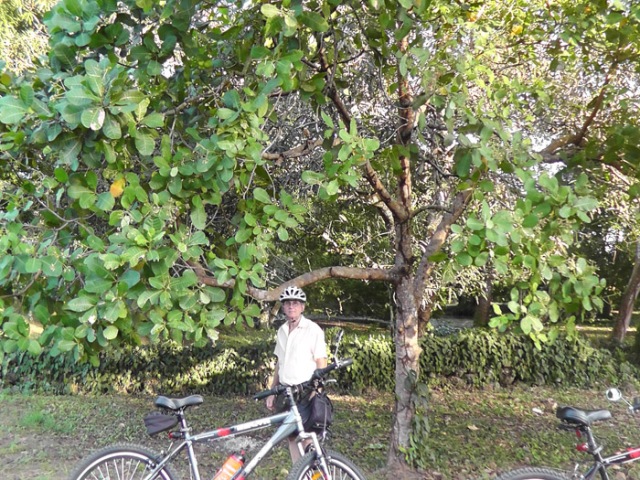
We first noticed a cashew tree when we were bike riding and stopped by the side of the road. We saw things on the tree that I thought must be cashews.
So, I went home and did a bit of research. What I found about cashew trees did indeed look like this tree. Once I knew what to look for, I started seeing cashew trees all over town!
Later, I saw a fruit at the produce market that reminded me of pictures I’d seen in my cashew research. What is it? Marañón. When I came home I looked at my jar of cashews from PriceMart and sure enough, “semillas de marañón”! Apparently semmilas (seeds) is the nuts, and marañón is the fruit.
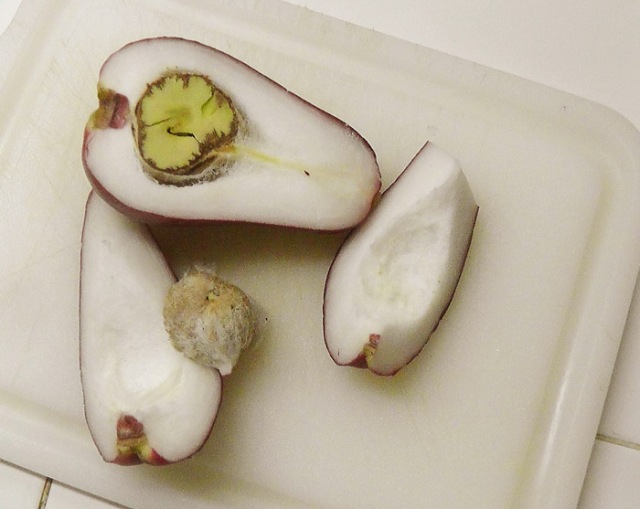
This is the fruit cut open. The flesh is very light and delicate, soft but not mushy, white, mildly sweet but without a distinctive flavor or much juice. The skin is soft and smooth, and the nut inside is very pretty (but I didn’t try to eat that part)
Meanwhile, there is a very pretty tree in our neighbor’s back yard just on the other side of our fence.
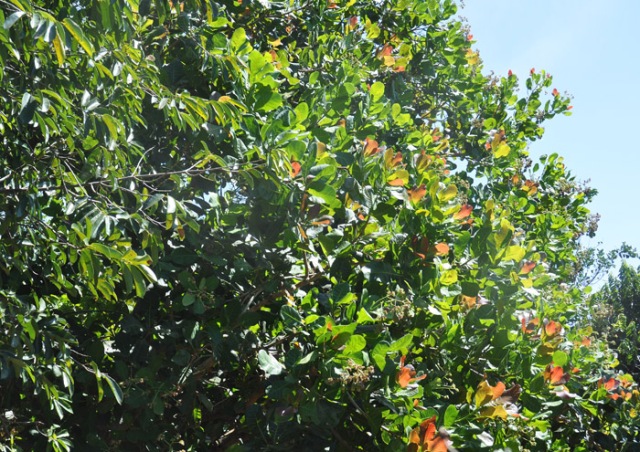
The neighbor’s tree, which has been flowering. I think the reddish leaves are pretty. One day I noticed it has a few cashews on it!
A little time passes, and one evening we take a walk around the block instead of our usual route toward the neighborhood entrance.
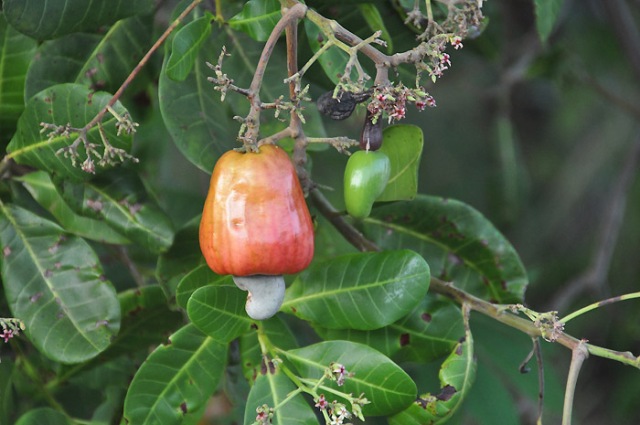 It’s a bit lighter color than the fruit I bought, and has the nut on the end (which apparently had been removed from the fruit I bought?)
It’s a bit lighter color than the fruit I bought, and has the nut on the end (which apparently had been removed from the fruit I bought?)
Next, as we are leaving our neighborhood, I notice the cashew by the side of the road has developed fruit.
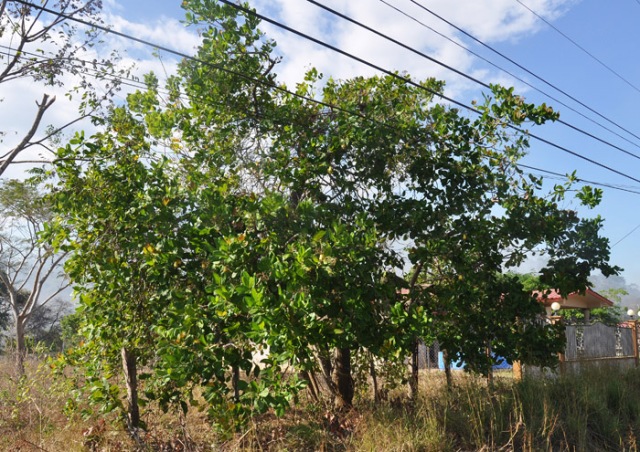
The fruit isn’t obvious at first glance, which is why sometimes it is nice to go walking. You notice more little things.
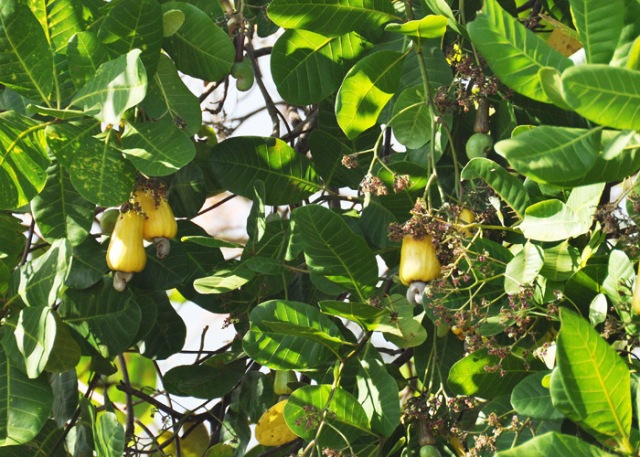
It definitely has yellow fruit! I noticed though that most of them are on the west side of the tree.
OK, back to cashews and marañón. My neighbor tells me that there are two kinds of fruit and only one is good to eat (the red one I bought). I am curious to get a red fruit from the tree down the street to see if it is the same, and to see if it has a pit inside.

Curiosity overcame me and I brought one home. It did not have a nut or pit inside. It has an odd flavor, not bad, just odd, not especially sweet. The fruit is very light, not very juicy, but almost not edible either. It’s more like something you chew for flavor and then spit out the pulp. It wasn’t quite like chewing gum, but not like fruit either. It’s an odd thing and hard to describe.
From what I’ve read and observed, the nuts develop first and then the fruits grow later. The skin of the fruit is fragile and delicate, so it doesn’t transport well. This is why you don’t see these fruits outside of the areas where they grow. I also read that the nuts contain a substance in the skin that is very irritating, but the roasting process gets rid of the problem.
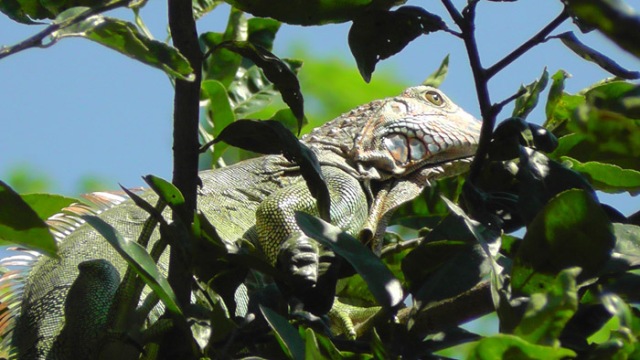
This is not a cashew. I figured I’d toss in a little surprise for those of you who hung in there until the end. We were eating lunch outdoors one day and this guy came through the fence and went up the limón tree. Joel got this shot, very lucky because shortly afterward he hid himself in the tree so well that neither of us had a clue where he went.
It sure is interesting living in a new place with so many new things to learn about!

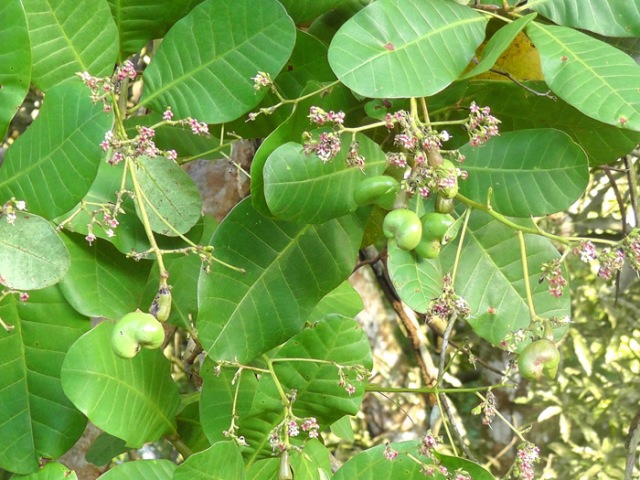
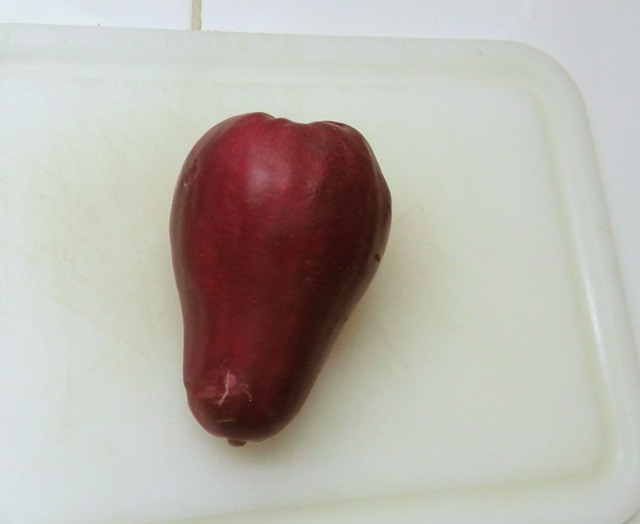
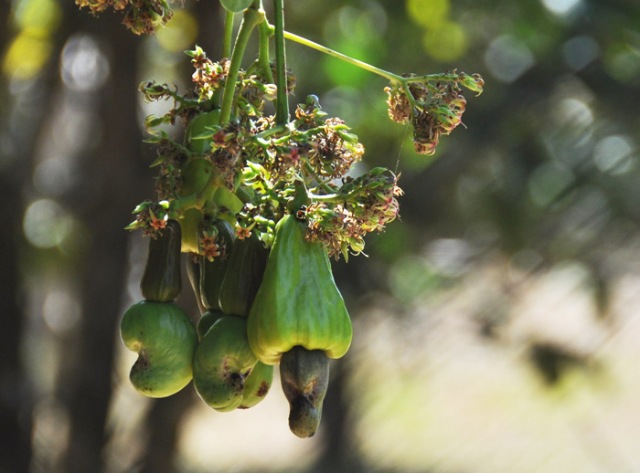

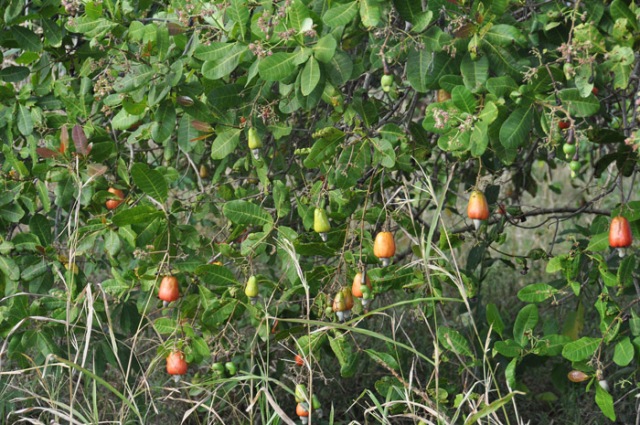
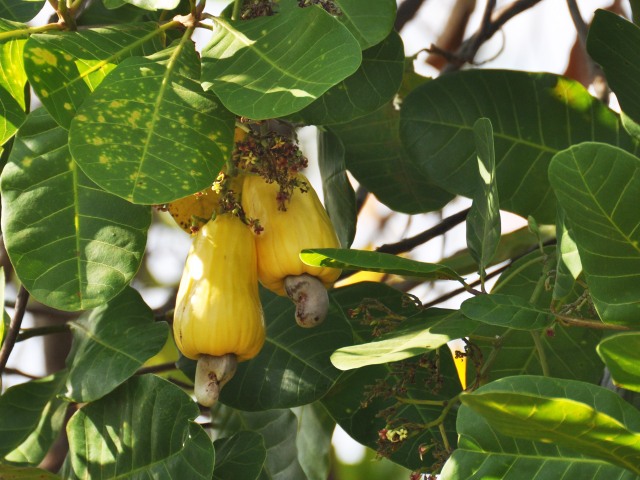









Krist,
You have posted the pictures of two different fruits; the first one you have -with the seed inside- we call “marañon ‘corazado” and I don’t know what its real name is and the second one that ripe is often red but can be yellow and which seed we eat after getting rid of its terrible taste by “toasting” it and is called cashew in English.
Both of these friuts are great but they (I believe w/o having studied bonaty) are from different families. The “marañón ‘corazado” ripens at the same time while the cashew fruit becomes ripe in a more spaced, in reference to time, manner. I wouldn’t eat the semilla of the first one but let us know how it tastes if you end up trying it.
There are many more fruits you will eventually come across sadly most of our fruits are not appreciated by us and its trees are become more and more rare. Many others you will find are fruits brought from South East Asia and who knows where else.
LikeLike
Really! That would explain why one had a pit in it, and the other did not. And the marañón on the trees here feel almost oily or waxy, where the one I bought did not. Thank you, and I will continue to research this, and any other new and interesting fruits I come across 🙂
LikeLike
The marañon fruit is not so good to eat directly. At least for me. It is sweet with a sour taste. My middle son and other people likes to eat the fruit. Some people prefer to get the juice out of the fruit and do a cool and delicious refreshment. The nut has a corrosive liquid that you should be careful. When I was a kid and visited family in the “interior” at “summer” vacation I collected the seeds and roasted them in the back yard to get the nut.
LikeLike
I’ve heard something about the drink people make. I’m not too fond on the fruit either so maybe I’ll have to try the drink. I’ve also heard that the covering around the nut has something very irritating in it, so I will stay away from them and let someone more experienced roast them. Thanks for your comments 🙂
LikeLike
Thanks for the track back. If you’re a facebook user we’d love for you to “like” the RAXA Collective page. See you there!
LikeLike
Yep, found you there too 🙂
LikeLike
Thanks so much!
LikeLike
My pleasure, looks like you are working on some very good things.
LikeLike
hey! i remember walking into my friend’s restaurant in costa rica and saying, ‘ahhhh, maranon!’ she cooks the fruit on ow heat with brown sugar for hours, and wow, it makes an amazing preserve/prune-like dessert. it’s so rich, but is great with ice cream!
i like to place a few ripe fruit in my house – the aromas permeate the rooms! be very careful with the juices from all of the plant.. if i remember correctly, it’s in the sumac family, and certain people would have a strong allergic reaction in addition. i know a costa rican child whose lips/face/chin were scarred from eating the fruit.
ah, the hidden dangers in paradise!
LikeLike
Thankfully I do not seem to be allergic since I survived my taste testing unscathed. I don’t remember an aroma but the fruit was barely in the house for any time. I’ll have to get another and see how that goes.
LikeLike
I hope this video doesn’t bore you; it’s from our 2009 trip to the Panafrut company operation in Coclé where the marañón are processed into cashews:
LikeLike
Oh my no, not at all! Thank you so much. That’s a great video and I loved the whole thing. I was very interested to see the part with the cashews too. I will never again complain about the price of them, when I think of those people spending all day roasting and cracking and sorting.
LikeLike